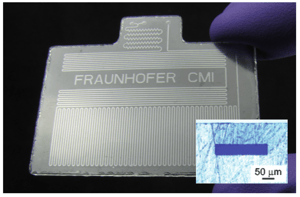Wouldn’t it be great to walk into your neighborhood pharmacy and find out what was making you ill in the time it took you to buy some cough drops? Lab-on-a-chip (LOC) devices have the potential to revolutionize health care by translating complex diagnostic assays into user-friend ly platforms. An additional advantage of LOC is a reduction in the required volume of sample and reagents. This competitive edge reduces costs and opens the door for bringing these tests into your local clinic. A key part of reducing costs is utilizing high-volume manufacturing methods like roll-to-roll (R2R) processing where 17,000 such devices can be produced each hour. With such obvious advantages, why aren’t all LOC devices manufactured by these methods?
ly platforms. An additional advantage of LOC is a reduction in the required volume of sample and reagents. This competitive edge reduces costs and opens the door for bringing these tests into your local clinic. A key part of reducing costs is utilizing high-volume manufacturing methods like roll-to-roll (R2R) processing where 17,000 such devices can be produced each hour. With such obvious advantages, why aren’t all LOC devices manufactured by these methods?
A major obstacle to scaling up production volumes lies in the chip dimensions and sealing the chip closed. All channels in the microfluidic device must be shallow enough to fit in the ultra-thin plastic layers used in R2R. When channels are just 50 µm deep, sealing the device by pressing the chip top and bottom together can cause substantial deformation and destroy the chip. How can teams get around this problem and bring their favorite diagnostic to the market?
The combined teams at Fraunhofer CMI in Boston, MA and Fraunhofer IPT in Aachen, Germany have developed a straightforward and practical approach to optimize channel integrity in R2R-compatible LOC. The team shows that ultra-thin (600 µm) sealed chips can be made in highly desirable thermoplastics without compromising channel function. This work paves the way for Fraunhofer and others to deliver the right diagnosis just in time for you to pick out your favorite flavor of cough medicine. For the full article published in Biomedical Microdevices, click here.